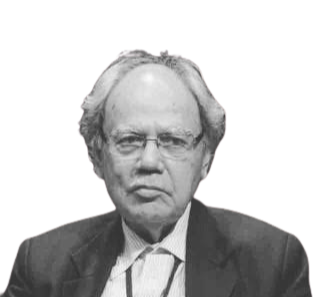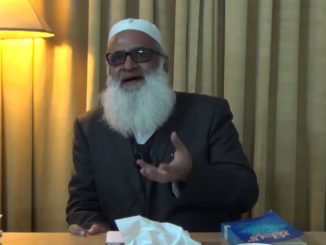
Shamim Hanafi, the flame that’s extinguished
by, Meraj Rana
Extinguish the same lamp whose flame was very high
This verse (misra) of Iftikhar Arif is applied to the death of prominent Urdu critic Shamim Hanafi (1939-2021).
There is no doubt that Shamim Hanafi is one of the important critics who have enriched Urdu criticism. There are so many aspects of his literary life. He was an excellent poet, playwright and a very good translator. But the strongest reference to his literary identity is his criticism. Jadeediyat ki Falsafiyana Asaas, Nai Sheri Riwayet and Ghazal ka Naya Manzarnama are his representative critical works.
An in-depth study of these books, on the one hand, gives an idea of the gradually changing situation of Urdu criticism and, on the other hand, helps in understanding his critical ideas and methods. That is to say, Shamim Hanafi’s critical position is quite clear from the above books.
His book Jadeediyat ki Falsafiyana Asaas is important not only because it discusses the rationale for writing under the influence of the philosophy of existentialism but also explains how existentialism or any philosophy in the creation of literature plays an important role.
Since Shamim Hanafi was also a proponent of that era which is called the era of modernity, most of his critical writings from beginning to end seem to have all the major debates related to modernity. But he does not seem to be bound by a particular ideology like other modernist critics.
He was a supporter of interdisciplinary studies, so he valued every good and true literature, whether it was written from a progressive or post-modern point of view. We all know that one of the primary tasks of the literary criticism and the critic is to highlight the value of a work of art as well as to create a brilliant reader. And this, criticism can be done when it seems to reject any myth or assumption. This was present in Shamim Hanafi’s critical consciousness as a firm belief.
Probably this was the reason why he did not accept any art with its positive attitude as we had a tradition of accepting it. This means that Shamim Hanafi used to base his critical action on a work of art on the basis of suspicion so that the work could be read and understood freely. An excellent example of this method is the article he wrote on Prem Chand’s story Kafan. This article is probably included in his book Kahani ke Paanch Rang. Prem Chand’s story Kafan is generally considered a great story.
Shamim Hanafi has not directly questioned the greatness of this story, but this article deprives him of all the claims on the basis of which the greatness of Kafan was determined. This means that all the arguments of indifference given to this story are scattered in this article of Shamim Hanafi.
One of the main virtues of Shamim Hanafi’s criticism is his cultural attachment. His attitude of looking at any artwork in its cultural context seems to be very strong. One of the greatest virtues of any great criticism is their in-depth study and their retentive memory. I have no hesitation in saying here that Shamim Hanafi had these two things in abundance which can be seen in his speech and writing.
Extinguish the same lamp whose flame was very high
This verse (misra) of Iftikhar Arif is applied to the death of prominent Urdu critic Shamim Hanafi (1939-2021).
There is no doubt that Shamim Hanafi is one of the important critics who have enriched Urdu criticism. There are so many aspects of his literary life. He was an excellent poet, playwright and a very good translator. But the strongest reference to his literary identity is his criticism. Jadeediyat ki Falsafiyana Asaas, Nai Sheri Riwayet and Ghazal ka Naya Manzarnama are his representative critical works.
An in-depth study of these books, on the one hand, gives an idea of the gradually changing situation of Urdu criticism and, on the other hand, helps in understanding his critical ideas and methods. That is to say, Shamim Hanafi’s critical position is quite clear from the above books.
His book Jadeediyat ki Falsafiyana Asaas is important not only because it discusses the rationale for writing under the influence of the philosophy of existentialism but also explains how existentialism or any philosophy in the creation of literature plays an important role.
Since Shamim Hanafi was also a proponent of that era which is called the era of modernity, most of his critical writings from beginning to end seem to have all the major debates related to modernity. But he does not seem to be bound by a particular ideology like other modernist critics.
He was a supporter of interdisciplinary studies, so he valued every good and true literature, whether it was written from a progressive or post-modern point of view. We all know that one of the primary tasks of the literary criticism and the critic is to highlight the value of a work of art as well as to create a brilliant reader. And this, criticism can be done when it seems to reject any myth or assumption. This was present in Shamim Hanafi’s critical consciousness as a firm belief.
Probably this was the reason why he did not accept any art with its positive attitude as we had a tradition of accepting it. This means that Shamim Hanafi used to base his critical action on a work of art on the basis of suspicion so that the work could be read and understood freely. An excellent example of this method is the article he wrote on Prem Chand’s story Kafan. This article is probably included in his book Kahani ke Paanch Rang. Prem Chand’s story Kafan is generally considered a great story.
Shamim Hanafi has not directly questioned the greatness of this story, but this article deprives him of all the claims on the basis of which the greatness of Kafan was determined. This means that all the arguments of indifference given to this story are scattered in this article of Shamim Hanafi.
One of the main virtues of Shamim Hanafi’s criticism is his cultural attachment. His attitude of looking at any artwork in its cultural context seems to be very strong. One of the greatest virtues of any great criticism is their in-depth study and their retentive memory. I have no hesitation in saying here that Shamim Hanafi had these two things in abundance which can be seen in his speech and writing.




